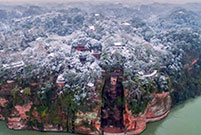

SAN FRANCISCO, Feb. 14 -- U.S. researchers have found a new way to produce nanoscale wires, with diameters as small as 200 nanometers, or billionths of a meter, that can serve as tiny, tunable lasers.
The project was led by Peidong Yang, a chemist at the U.S. Department of Energy's Lawrence Berkeley National Laboratory and University of California, Berkeley.
In a paper published in Proceedings of the National Academy of Sciences, researchers said they have developed a simple chemical-dipping solution process to produce a self-assembled blend of nanoscale crystals, plates and wires composed of cesium, lead and bromine (with the chemical formula: CsPbBr3).
"What's amazing is the simplicity of the chemistry here," said Yang.
The same chemical blend, with a molecular architecture composed of cube-like crystal structures, has proven effective in an emerging wave of new designs for high-efficiency solar cells.
"Most of the earlier work with these types of materials is focused on these solar energy applications," said Yang. "There has been so much progress with these materials in just the past several years - I have a feeling these materials will open a new research frontier for optoelectronics as well."
His research team pioneered the development of nanowire lasers almost 15 years ago using a different blend of materials, including zinc oxide (ZnO) and gallium nitride (GaN).
In the latest work, the team discovered how to produce nanowires by dipping a thin lead-containing film into a methanol solution containing cesium, bromine and chlorine heated to about 122 degrees Fahrenheit, or 50 degrees Celsius. A mix of cesium lead bromide crystalline structures formed, including nanowires with a diameter from 200 to 2,300 nanometers, or 0.2 to 2.3 microns, and a length ranging from 2 to 40 microns.
Select nanowires used in the experiment were placed on a quartz base and excited by another laser source that caused them to emit light. The nanowire lasers emitted light for over 1 billion cycles after being hit by an ultrafast pulse of visible, violet light that lasted just hundredths of quadrillionths of seconds.
Yang said that to his knowledge these nanowires may be the first to emit laser light using a blend of materials totally inorganic, namely containing no carbon. Researchers demonstrated that the lasers could be tuned to a range of light including visible green and blue wavelengths.
"The whole purpose of developing nano-sized lasers is to interface photonic (light-based) devices with electronic devices seamlessly," he said, "at scales relevant to today's computer chips. Today, these photonic devices can be bulky."
The nanowires' crystalline structure is a lot like salt, which does make them susceptible to damage from moisture in the air, said Yang, who described it as "one weakness - something we have to study and understand how to improve."
 Have you ever taken these beautiful subways in China?
Have you ever taken these beautiful subways in China? Chinese beauties, foreign models meet in Chengdu
Chinese beauties, foreign models meet in Chengdu Awesome! Aerial pictures taken on J-11 fighter
Awesome! Aerial pictures taken on J-11 fighter A foreign girl explains what China should be proud of
A foreign girl explains what China should be proud of Chinese navy's air-cushioned landing craft in pictures
Chinese navy's air-cushioned landing craft in pictures Chinese pole dancing master opens class in Tianjin
Chinese pole dancing master opens class in Tianjin Splendid Sichuan after snow
Splendid Sichuan after snow College girl of Vancouver crowned Miss Chinese Int'l 2016
College girl of Vancouver crowned Miss Chinese Int'l 2016 Pentagonal Mart becomes the largest vacant building in Shanghai
Pentagonal Mart becomes the largest vacant building in Shanghai Top 20 hottest women in the world in 2014
Top 20 hottest women in the world in 2014 Top 10 hardest languages to learn
Top 10 hardest languages to learn 10 Chinese female stars with most beautiful faces
10 Chinese female stars with most beautiful faces China’s Top 10 Unique Bridges, Highways and Roads
China’s Top 10 Unique Bridges, Highways and Roads I heart you!
I heart you! Real kung fu pandas
Real kung fu pandas Young Chinese feeling trapped by pressure to marry
Young Chinese feeling trapped by pressure to marry Monks rebuff allegations that religion is under tighter control
Monks rebuff allegations that religion is under tighter controlDay|Week